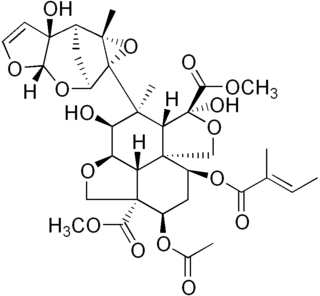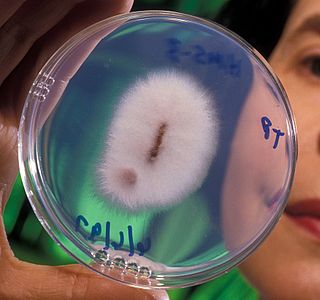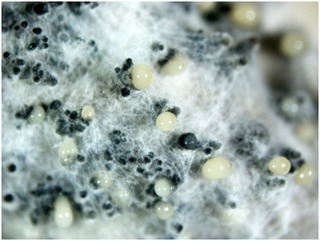
Azadirachta indica, commonly known as neem, nimtree or Indian lilac, is a tree in the mahogany family Meliaceae. It is one of two species in the genus Azadirachta, and is native to the Indian subcontinent. It is typically grown in tropical and semi-tropical regions. Neem trees also grow in islands located in the southern part of Iran. Its fruits and seeds are the source of neem oil.

Azadirachtin, a chemical compound belonging to the limonoid group, is a secondary metabolite present in neem seeds. It is a highly oxidized tetranortriterpenoid which boasts a plethora of oxygen-bearing functional groups, including an enol ether, acetal, hemiacetal, tetra-substituted epoxide and a variety of carboxylic esters.

Fusarium oxysporumpronounce (help·info), an ascomycete fungus, comprises all the species, varieties and forms recognized by Wollenweber and Reinking within an infrageneric grouping called section Elegans. It is part of the family Nectriaceae.

The curry tree is a tropical to sub-tropical tree in the family Rutaceae, and is native to Asia. The plant is also sometimes called sweet neem, though M. koenigii is in a different family to neem, Azadirachta indica, which is in the related family Meliaceae.

Neem oil is a vegetable oil pressed from the fruits and seeds of the neem, an evergreen tree which is indigenous to the Indian subcontinent and has been introduced to many other areas in the tropics. It is the most important of the commercially available products of neem for organic farming and medicines.
Neem cake organic manure is the by-product obtained in the process of cold pressing of neem tree fruits and kernels, and the solvent extraction process for neem oil cake. It is a potential source of organic manure under the Bureau of Indian Standards, Specification No. 8558. Neem has demonstrated considerable potential as a fertilizer. For this purpose, neem cake and neem leaves are especially promising. Puri (1999), in his book on neem, has given details about neem seed cake as manure and nitrification inhibitor. The author has described that, after processing, neem cake can be used for partial replacement of poultry and cattle feed.

Trichoderma viride is a fungus and a biofungicide.

Dead arm, sometimes grape canker, is a disease of grapes caused by a deep-seated wood rot of the arms or trunk of the grapevine. As the disease progresses over several years, one or more arms may die, hence the name "dead arm". Eventually the whole vine will die. In the 1970s, dead-arm was identified as really being two diseases, caused by two different fungi, Eutypa lata and Phomopsis viticola.

Verticillium dahliae is a fungal plant pathogen. It causes verticillium wilt in many plant species, causing leaves to curl and discolor. It may cause death in some plants. Over 400 plant species are affected by Verticillium complex.

Forest dieback is a condition in trees or woody plants in which peripheral parts are killed, either by pathogens, parasites or due to conditions like acid rain and drought. Two of the nine tipping points for major climate changes forecast for the next century, are directly related to forest diebacks.
Piriformospora is a fungal genus of the order Sebacinales. It is a monotypic genus, containing the single endophytic root-colonising species Piriformospora indica, discovered from orchid plants in the Thar desert in Rajasthan, India by Prof. Ajit Verma and group, School of Life Sciences, Jawaharlal Nehru University, New Delhi. The fungus has typical pear-shaped chlamydospores, and thus, named as P. indica . Unlike mycorrhizal fungi, which cannot be cultured axenically, P. indica can be easily grown on various substrates. It has been found to promote plant growth during its mutualistic symbiotic relationship with a wide variety of plants. Experiments have shown that P. indica increases the resistance of colonized plants against fungal pathogens. It has also been found in experiments with barley that P. indica-inoculated plants are tolerant to salt stress and more resistant to root pathogens. P. indica-infested roots also show antioxidant capacity. The fungus also induces systemic disease resistance in plants. P. indica was found to require host cell death for proliferation during mutualistic symbiosis in barley. Its genome has been sequenced and was published in 2011.
Commonly known as Philippine downy mildew, this disease is caused by the species Peronosclerospora philippinensis of the fungal-like protist class Oomycetes, which also has members such as water molds and Phytophthora infestans, which caused the potato blight that led to the Great Irish famine.
Fusarium mangiferae is a fungal plant pathogen that infects mango trees. Its aerial mycelium is white and floccose. Conidiophores on aerial mycelium originating erect and prostrate from substrate; they are sympodially branched bearing mono and polyphialides. Polyphialides have 2–5 conidiogenous openings. Phialides on the aerial conidiophores mono- and polyphialidic. Sterile hyphae are absent. Microconidia are variable in shape, obovoid conidia are the most abundant type, oval to allantoid conidia occurring occasionally. Microconidia mostly 0-septate with 1-septate conidia occurring less abundantly. Sporodochia are present. Macroconidia are long and slender, usually 3–5 septate. Chlamydospores are absent.

Phomopsis longicolla is a species of ascomycete fungus in the family Diaporthaceae. It is a plant pathogen and mainly responsible for a soybean disease called Phomopsis seed decay (PSD). In other plant species, P. longicolla can also live as an endophyte, such as in the mangrove plant Sonneratia caseolaris. P. longicolla has also been found to produce a number of cytotoxic and antimicrobial secondary metabolites, especially members of the class of phomoxanthones. P. longicolla was first described in 1985 by Thomas W. Hobbs et al. at the Department of Plant Pathology at Ohio State University.
Microsporum nanum is a pathogenic fungus in the family Arthrodermataceae. It is a type of dermatophyte which causes infection in dead keratinized tissues such as skin, hair, and nails. Microsporum nanum is found worldwide and is both zoophilic and geophilic. Animals such as pigs and sheep are the natural hosts for the fungus; however, infection of humans is also possible. Majority of the human cases reported are associated with pig farming. The fungus can invade the skin of the host; if it is scratched off by the infected animal, the fungus is still capable of reproducing in soil.
Penicillium citrinum is an anamorph, mesophilic fungus species of the genus of Penicillium which produces tanzawaic acid A-D, ACC, Mevastatin, Quinocitrinine A, Quinocitrinine B, and nephrotoxic citrinin. Penicillium citrinum is often found on moldy citrus fruits and occasionally it occurs in tropical spices and cereals. This Penicillium species also causes mortality for the mosquito Culex quinquefasciatus. Because of its mesophilic character, Penicillium citrinum occurs worldwide. The first statin (Mevastatin) was 1970 isolated from this species.

Deoxygedunin, or 14,15-deoxygedunin, is a naturally occurring tetranortriterpenoid isolated from the Indian neem tree, a plant that has been used in India since ancient times as a remedy for various ailments. Deoxygedunin has been found to act as a potent, selective, small-molecule agonist of TrkB, the main receptor of brain-derived neurotrophic factor (BDNF). It produces TrkB-dependent neurotrophic and neuroprotective effects in mice and enhances learning processes. In addition, deoxygedunin evokes rapid TrkB-dependent antidepressant-like effects in the forced swim test, an animal model of depression, similarly to 7,8-dihydroxyflavone (7,8-DHF) and ketamine, and notably with a greater potency than 7,8-DHF. The compound was discovered by the same group that identified 7,8-DHF and N-acetylserotonin as TrkB agonists.
Microbacterium azadirachtae is a Gram-positive, non-spore-forming and motile bacterium from the genus of Microbacterium which has been isolated from the rhizoplane of the plant Azadirachta indica from the Botanical Garden of Coimbatore in India. Microbacterium azadirachtae can promote plant growth by producing phytohormones.
Nihar Ranjan Jana is an Indian neuroscientist and a professor at the National Brain Research Centre. Known for his studies on E3 ubiquitin ligases, Jana is an elected fellow of the National Academy of Sciences, India. The Department of Biotechnology of the Government of India awarded him the National Bioscience Award for Career Development, one of the highest Indian science awards, for his contributions to biosciences in 2008.
Manmohan Parida is an Indian virologist, microbiologist and the joint director of the Defence Research and Development Establishment. He is known for his molecular epidemiological studies of viral infections as well as studies related to epidemics and public health. The Department of Biotechnology of the Government of India awarded him the National Bioscience Award for Career Development, one of the highest Indian science awards, for his contributions to biosciences, in 2011.










